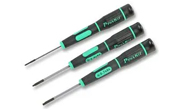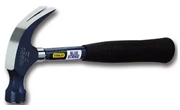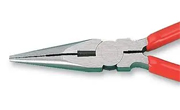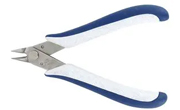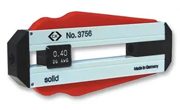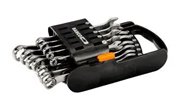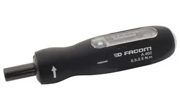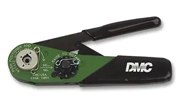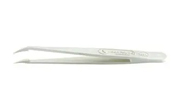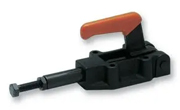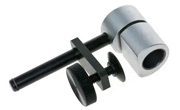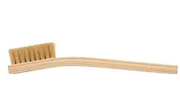Mastering industrial hand tools
Your oultimate guide for versatile applications
Hand tools are important to human progress. They have evolved from simple implements to advanced, specialized devices that drive industrial efficiency, precision, and safety. This article explores the range of hand tools used in industrial settings, from basic to specialized equipment. It examines each tool’s unique features and applications and highlights key factors in choosing the right tools for specific tasks, ensuring you’re equipped with the best solutions for every job.
Types of Industrial Hand Tools
- Screwdrivers: Screwdrivers are versatile hand tools essential for industrial use. These are available in different types based on screw head designs.
- Slotted screwdrivers: Comes with a flat blade. These were once widely used but have declined in popularity due to the challenge of maintaining the grip without damaging the screw head.
- Phillips screwdrivers: have a cross-shaped tip with four arms, which are perfect for cross slots. These are marked with a size number and provide more grip precision, making them suitable for heavy-duty industrial applications in electronics, appliances, and automotive applications.
- Torx screwdrivers: These six-pointed screwdrivers are ideal for star-shaped recesses. They provide excellent contact, allowing high torque without stripping. However, they require a clean screw head for an adequate grip.
- Hex drive screwdrivers: These feature a hexagonal tip designed for screws with a matching hexagonal socket. They are also known as Allen wrenches and are commonly used for assembling furniture, making bicycle repairs, and working on machinery.

Figure 1: Screwdriver Kit, Phillips, Torx, Hex, Slotted, Assorted Accessories (Source)
Striking tools: Striking tools are designed to meet the specific demands of their application, providing durability, functionality, and comfort to the user. Below are the different types-
- Club hammers: Ideal for light demolition, stone cutting, and driving masonry nails. Most of the time, these are equipped with soft grip handles for added comfort during use.
- Copper hammers: Made from softer metal that meets compliance with DIN, ANSI, and ISO standards and has fiberglass handles for durability. These are used on machinery for controlled force with minimal damage and reduced spark risk.
- Rubber hammers: Made with high quality rubber that meets ISI specifications for consistency and suitable for upholstery, sheet metal work, and home projects like tile adjustments.
- Machinist hammers: Designed with a unique, variable-shaped peen opposite the striking face for precision work, which is suitable for metalworking and fabrication.
- Mallets: Ideal for precise and controlled striking without damaging the material. Mainly used in carpentry for assembling wood pieces.
- Sledgehammers: These are designed for heavy-duty applications in construction, like breaking concrete and driving stakes.

Figure 2: Claw Hammer, Blue Strike, Tubular Steel Handle, 450 g (Source)
Pliers: Pliers are among the most essential tools in various industries, especially construction, electrical work, jewelry making, and household repairs. Available in various types, each plier type serves a specific purpose.
- Combination pliers: Also known as slip-joint pliers, these are among the most widely used types, featuring both flat and curved jaws to grip flat or round objects, with adjustable jaw-opening sizes for flexibility.
- Adjustable pliers: Commonly called channel locks, these have a multi-position slip joint that adapts to different sizes, ideal for tasks that require varied grip widths.
- Needle nose pliers: They have long, tapered jaws that easily reach small parts or tight spaces and include wire-cutting edges and a wire stripper. These are used for precision tasks.
- Locking pliers: They can be tightly secured around an object, making them incredibly useful for holding parts together. They're convenient for gripping rounded fasteners that are difficult to turn with a wrench or socket. Available in various sizes and jaw configurations, locking pliers are versatile tools that are handy for many auto repair tasks.
- Diagonal-cutting pliers: These are designed with extra-hard cutting edges to handle electrical wires, cotter pins, etc.
- Snap-ring pliers: These have notched or toothed surfaces that provide a good hold, especially on circular fasteners.

Figure 3: Electronics Pliers Set in a Hard Wearing Polyester Fabric Case (Source)
Cutters and strippers: Cutters and strippers are indispensable tools for various tasks in electrical work, plumbing, and construction. They are designed for specific cutting and stripping needs.
- Cable cutters: Mainly used for electrical applications, these often have insulated handles to protect against electric shocks, and are perfect for slicing through thick cables without crushing the internal conductors.
- Side cutters: These provide precise trimming for various small components, including wire ends, and more delicate parts, commonly used in crafting industry and electronic work.
- Flush cutters: These have narrow, angular pincers that enable precise cutting of soft and semi-hard metals. Their unique design helps make them ideal for trimming delicate components without leaving any sharp edges. This makes flush cutters an excellent choice for tasks that require accuracy and a clean finish like eyepins, headpins and beading wire.
- End cutters: These have a flat head for cutting materials close to surfaces. This design is helpful for tasks like cutting leads, springs, nails and rivets.
- Diagonal cutters: Designed to provide precise cuts at an angle, making them ideal for crimping and wedging cables apart. They are commonly used in electrical work, particularly for cutting soft copper or aluminium conductors.
- Wire strippers: These tools have two opposite blades, similar to scissors with a center notch that carefully removes insulation without damaging the wire.

Figure 4: WIRE STRIPPERS (Source)

Figure 5: Cutter, Side, 142 mm, Flush, 1.8 mm (Source)
Spanners and wrenches: A spanner is a fixed tool that is designed for turning nuts and bolts to either tighten or loosen. It's ideal for operations that require precision or in tight spaces where maneuverability is limited. A wrench is an adjustable tool with a movable lower jaw that can be adjusted to fit various bolt or nut sizes. Due to their adjustable design, wrenches provide more flexibility for different applications.
- Ring spanners: These can fully encircle nuts and bolts and provide a firm grip on hex or square heads, which makes them very useful for accessing tight spaces.
- Combination spanners: These tools have a ring end on one end and an open end on the other. This unique feature makes them a versatile fastening tool which is helpful in automative and industrial work.
- Adjustable wrenches: Their adjustable jaws fit multiple sizes.
- Torque wrenches: These are designed for applying specific torque in special operations like automotive repairs and tyre changes.
- Pipe wrenches: Available with adjustable jaws for different pipe diameters. They provide a firm grip for round surfaces which makes them essential for plumbing works.
- L and T spanners: L spanners can reach inaccessible bolt heads with angled tips for high-torque applications. T-spanners have long rods for extra reach and rubber grips for comfort.
- Allen keys: These are specially designed for hexagonal fasteners widely used in machinery, electronics, and furniture assembly.
- Torx wrenches: These are star-shaped fasteners that reduce the risks of stripping.

Figure 6: Spanner Set, Self-Adjustable, VDE, 4 Pieces, Joker 6004 Series (Source)

Figure 7: Torque Wrench Set, A2, 2N-m to 12N-m, 23 Pieces (Source)
Crimping tools: Crimpers are essential in creating secure cold weld joints between wires or between a wire and a connector like a lug, ensuring strong electrical and mechanical properties similar to the parent materials. These can be sized based on AWG (American Wire Gauge) with options for interchangeable die hands to accommodate different wire sizes and connectors. Types of crimping tools include:
- Manual handheld crimpers are lightweight and portable, making them ideal for smaller tasks. The dies are usually swappable and capable of 180 terminations per hour.
- Battery-powered handheld crimpers: These electric tools provide productive and high-quality crimping. They have a modular head that allows up to 200 terminations per hour.
- Manual and Electric Benchtop Crimpers: Designed for high-volume production, electric models can handle up to 2000 terminations per hour, producing high-quality crimps.
- Pneumatic Crimpers: These air-powered tools are available with flexible mounting options, which are suitable for heavy-duty operations. They are capable of up to 600 terminations per hour.
- Hydraulic Handheld Crimpers: Provide high force with minimal effort, featuring hydraulic fluid for compression and commonly used in industrial settings.

Figure 8: Crimp Tool, Hand, 0.08mm2 to 6mm2 Turned Crimp Contacts (Source)
Precision tweezers: These are highly specialized tools for detailed and delicate tasks in professional applications such as electronics, laboratory work, and fine assembly. Unlike typical household tweezers, precision tweezers come in various styles to meet specific needs.
- Bent tweezers: These come with a hooked tip that provides exceptional control in restricted areas, reducing user fatigue for lengthy tasks.
- Flat-tip tweezers: They provide a larger gripping surface and make it handy for the users.
- Round tip tweezers: These have a smooth curved tip that make it suitable for general purpose.
- Wafer tweezers: These have flat teeth for securely handling delicate silicon wafers in semiconductor manufacturing.
- Cutting tweezers: These have sharp edges designed for minor cuts on soft components, like wires.
- Blunt tweezers: These have rounded tips like rounded tweezers, but they are safe while handling delicate components.
- Pointed tweezers: These are recognized by their sharp points, which make them ideal for accessing low-space spots. However, due to their sharp ends, they require careful handling to avoid damaging sensitive parts.

Figure 9: Tweezer ESD Set with 6 Tweezers, PET Stainless Steel Body, Stainless Steel Tip (Source)
Vices and clamps: These are essential tools for securely holding workpieces in applications like woodwork, metalwork, and plumbing.
- Milling tables: Provide a fixed platform for machining various workpieces.
- C-clamps and G-clamps: C-clamps are known for versatility, and G-clamps are ideal for tightening screws. These are commonly used in carpentry and light industrial work, such as holding materials together.
- Parallel clamps: These are perfect for assembling projects requiring exact parallel alignments, like bookshelves or box structures, ensuring solid and accurate joints.
- Bench vices: They offer a sturdy grip on a workbench, which is ideal for general-purpose work holding.
- Machine vices: Installed on milling machines, drill presses, and grinding machines for more specialized tasks.

Figure 1: 300mm (12") Light Duty Pro Speed F Clamp (Source)
Key consideration while selecting a hand tool
Below are the key points to consider when hand tools are selected:
- Tool quality: It must be ensured the tool is made from durable materials for longevity and reliable performance.
- Ergonomics: Choose tools with comfortable grips and minimizing strain. Bent handles can be beneficial for horizontal tasks, while straight handles are better for vertical applications.
- Size and weight: Go for a size and weight that is manageable and appropriate for the work environment to avoid fatigue.
- Safety features: Look for tools without sharp edges on handles and those that are spring-loaded to return to an open position, which can improve safety during use. Not only this, tools must meet industry standards and safety requirements, especially when working in hazardous or electrical environments.
- Maintenance needs: Choose tools that are easy to clean, sharpen, or maintain to extend their lifespan and effectiveness.
- Cost-effectiveness: Balance quality with budget; sometimes, a higher initial investment can reduce replacement costs over time.
